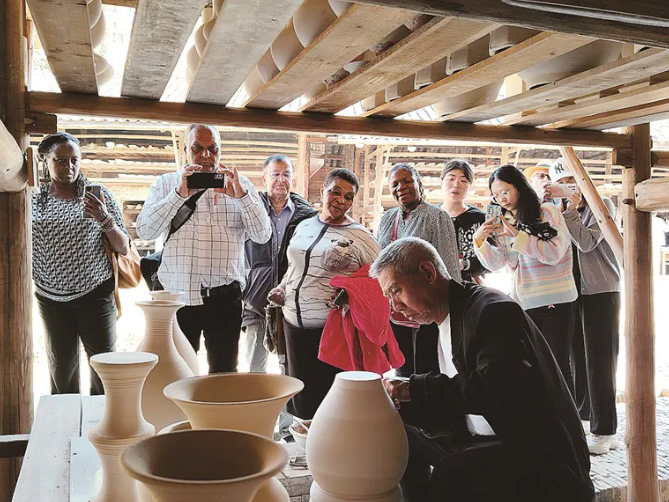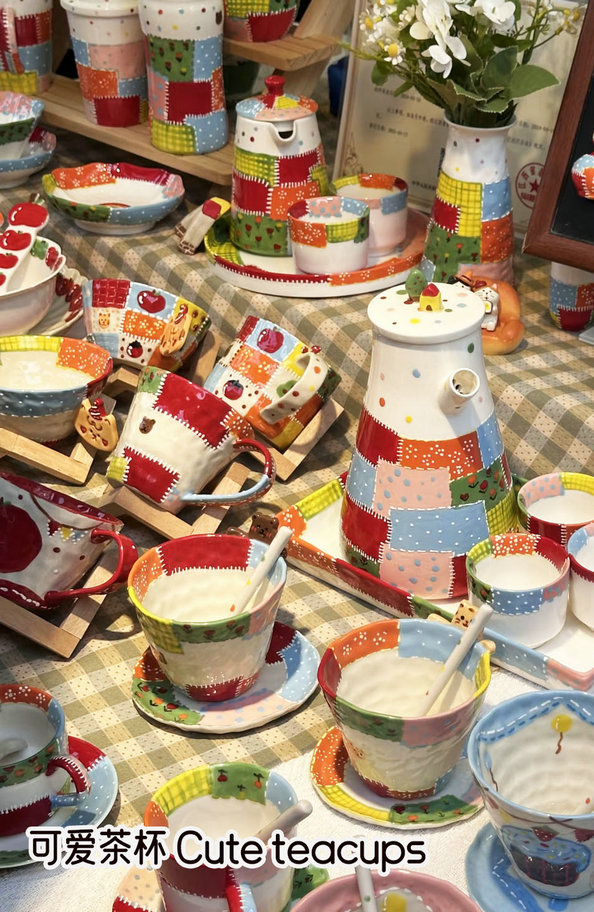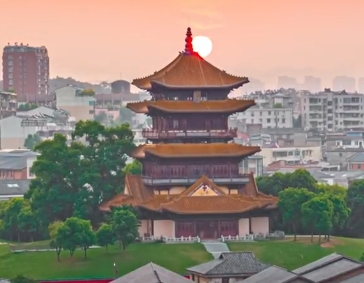
"Chinese excellent traditional culture has never been interrupted throughout history. Ceramics are a precious treasure of China and an important symbol of Chinese civilization." On October 11, 2023, when Xi Jinping, the general secretary of the CPC Central Committee, visited Jingdezhen for inspection and research, he made a profound statement that endowed the thousand-year-old porcelain capital with new contemporary connotations. Xi's continuous care for Jingdezhen has been consistent. As early as 2019, when he inspected Jiangxi Province, he made a strategic plan of "building the Jingdezhen National Ceramic Culture Inheritance and Innovation Experimental Zone and creating a new platform for external cultural exchanges."
Over the past two years, Jingdezhen has faithfully fulfilled its mission, persevered in its efforts, used porcelain as a medium and culture as a vehicle to build a splendid bridge of mutual learning and integration between Eastern and Western civilizations, and vividly written a new chapter of contemporary cultural dialogue.
Three sides are covered with mountains and one side is water. One part of the city is occupied by porcelain factories and the other half by kilns. Jingdezhen, where the kiln fires have been burning for thousands of years, is following the direction pointed out by Xi and transforming the rich heritage of "Chinese treasures" into a unique advantage for international exchanges.
In Jingdezhen, the scorching heat has not yet dissipated in August, but what is even more intense is a series of ceramic culture feasts. At the Global Ceramic Training Camp, dozens of foreign young ceramists from 8 countries and regions gathered in Sanbao Village for a 10-day ceramic art training and cultural exploration journey.
These international friends followed the pottery teacher and experienced in an immersive way every step of the traditional porcelain-making process in Jingdezhen - from the mixing of clay materials, the shaping by throwing the clay, the design of the shape, the application of glaze and coloring, all the way to the firing in the kiln. This was a profound exchange of cultures, and it was also a vivid practice of Jingdezhen's implementation of the important instruction of Xi "to build a new platform for cultural exchanges with the outside world", and to showcase "an important symbol of Chinese civilization".
The Historical Integration of the "Thousand-Year Porcelain Capital"
The history of porcelain production in Jingdezhen spans over a thousand years. "It summarizes the achievements of all the renowned kilns across the country and integrates the finest craftsmanship from various regions". From the smooth and jade-like texture of the Qingbai porcelain in the Song Dynasty, to the fusion of Eastern and Western styles in the blue-and-white porcelain of the Yuan Dynasty, and finally to the peak craftsmanship of the imperial kilns during the Ming and Qing dynasties, Jingdezhen porcelain has always been an important messenger in the dialogue between Chinese civilization and world civilizations.
History is the best witness. Archaeological discoveries show that porcelain from Jingdezhen had already been exported overseas via the Maritime Silk Road as early as the Song and Yuan dynasties. The Chinese export porcelain found in the Nanhai No.1 and Huaguang Reef No.1 ancient shipwrecks confirm the prosperity of the Maritime Silk Road, among which there are numerous exquisite works from the Jingdezhen kiln system. The large Yuan Dynasty blue and white porcelain plate in the Topkapi Palace in Turkey, with its grand shape and exquisite patterns, integrates traditional Chinese painting techniques with Islamic cultural aesthetics; the fine Ming and Qing Dynasty blue and white porcelain collections in the Ardabil Temple in Iran bear witness to the cultural exchanges between China and the Persian region.
In the 15th century, Zheng He made seven voyages to the Western Seas, bringing a large quantity of Jingdezhen porcelain to foreign countries, which promoted economic and cultural exchanges between China and various Asian and African nations. In the 18th century, a "Chinese style" craze swept across Europe, and Jingdezhen porcelain became highly sought-after treasures by royal families and nobles of various countries. The German Meissen Factory, by imitating Jingdezhen porcelain, produced the earliest hard porcelain in Europe; Japanese Aritayaki Kiln and Dutch Delft Blue Pottery were also greatly influenced by it.
Today, in museums across many countries around the world, one can see the works of Jingdezhen porcelain from all eras. These pieces stand silently, narrating the stories of exchanges spanning thousands of years and witnessing the profound influence of Chinese culture on world civilization. This open and integrating genetic trait from the depths of history has enabled the thousand-year-old porcelain to regain its brilliance in the new era, building a bridge for mutual learning of civilizations and injecting an endless stream of confidence and strength.
Contemporary Practice of Civilizational Dialogue
Back to April, 2025, the second Advanced Thermal Management Ceramics Forum was inaugurated in Mingfang Park. This grand event, focusing on the cutting-edge field of "thermal management", is not only a venue for the exchange of industry wisdom, but also a vivid window for observing the development of the Changnan New District, which uses advanced ceramics as its engine to promote new quality productive forces.
In the new era and new journey, Jingdezhen has actively taken on the cultural mission and proactively carried out cultural exchanges with other countries. From the end of May to the beginning of June in 2025, Mayor Hu Xuemei led the delegation of Jingdezhen City to conduct friendly visits to Turkey and Italy, initiating a profound "ceramic culture diplomacy".
In the Rize Province of Turkey, the "A Ceramic Tour on the Silk Road -To see China through Jingdezhen" Cultural and Tourism Promotion Event of Jingdezhen was successfully held. At the event site, a display area of Jingdezhen ceramic masterpieces was set up, showcasing representative porcelain categories such as blue and white, famille-rose, and colored glaze. Through video materials, the 72 steps of porcelain production were vividly presented. Master craftsmen from Jingdezhen demonstrated core techniques such as clay throwing, trimming, and painting, which attracted the attention and admiration of local people. The tourism and culture enterprises from both sides signed a strategic cooperation agreement, and will carry out in-depth cooperation in areas such as ceramic art exhibitions, craftsmanship training, and cultural product development.
In Rome, Italy, the Treccani Institute successfully held the "Silk Road Porcelain Journey - Rome Forum" of the China-EU Famous Cities Dialogue. Scholars and diplomatic figures from the cultural and artistic circles of China and Italy engaged in in-depth discussions around keywords such as civilization, inclusiveness, and resonance, laying a solid foundation for future cooperation between the two sides in areas such as cultural heritage protection and artistic innovation. During the forum, the guests also visited the "Legendary Journey - 16th Century Kiln Sites, Shipwrecks and Jingdezhen Porcelain in Oil Paintings" digital photo exhibition. Through archaeological discoveries, maritime trade, and porcelain elements in Western art, they gained a multi-dimensional understanding of the global influence of Jingdezhen ceramics.
This visit further strengthened the connection between Jingdezhen and the Italian cultural community. In June, Massimo Berretta, the former minister of the Italian Ministry of Culture and the director of the Treccani Institute, payed a return visit to Jingdezhen. The two sides discussed a pioneering cooperation to jointly compile a comprehensive encyclopedia of Chinese and Italian ceramic culture, which is expected to become a landmark achievement in cultural dialogue. During his visit to Jingdezhen, Massimo Berretta sincerely exclaimed: "Here, I not only witnessed the art and culture of Jingdezhen, but also deeply realized how important the restoration and protection work is for these precious cultural heritages."
These cultural exchange events and practical cooperation have fully demonstrated Jingdezhen's firm determination and effective actions in promoting cultural dialogue through its ceramic culture, and have continued the friendly exchange tradition of using porcelain as a medium to embrace the world.
A Vivid Scene of Diverse Integration
Today, Jingdezhen is embracing the world with a more open attitude and has become an important hub for global ceramic cultural exchanges. Taoxichuan Ceramic Art Avenue, as a concentrated manifestation of this trend, has received a total of 4,300 artists from 56 countries and regions to stay and create in recent years, forming a unique international art community. The Taoxichuan Spring and Autumn Art Fair held in the spring of 2025 attracted over 500,000 visitors in a single season, including a large number of international ceramic artists and collectors who came specifically for exchanges.
The deep involvement of international artists has enriched the cultural ecosystem of Jingdezhen. The Australian ceramic artist Greg Daly, who participated in the Spring and Autumn Fair in 2025, exclaimed: "I have attended over 250 exhibitions. This kind of event like the Spring and Autumn Art Fair is the first time for me. The atmosphere is great, very interesting, and it gave me a completely new experience." The Czech-Chinese artist Zhang Dan, who was engaged in on-site creation at the Taoxichuan International Studio, said: "Because of ceramics and events like the Spring and Autumn Art Fair, everyone is willing to come to Jingdezhen."
Jingdezhen has also actively established communication platforms, inviting ceramic artists and amateurs from all over the world to come to Jingdezhen to jointly discuss the development of ceramic art. The 21st China Jingdezhen International Ceramic Expo attracted nearly 1,000 foreign guests from 82 countries to attend, making it a more international and high-end event than previous ones. In addition, the "World Ceramic Heritage Workshop" program offered by Jingdezhen Ceramic University attracted students from 37 countries to participate. While learning the ancient wood-fired kiln firing techniques, they also told the story of porcelain making in their native languages on the live streaming platform, promoting exchanges and understanding among different cultures.
In August 2025, the "Cross-disciplinary Ceramic Design Works Collection Activity" was officially launched. This event will provide an important communication platform for global ceramic creative design talents, further promoting the innovative development of Jingdezhen ceramic culture, comprehensively facilitating the career development of ceramic design talents, and injecting strong momentum into the modernization transformation of traditional Chinese craftsmanship.
These solid data and specific examples vividly demonstrate the remarkable achievements of Jingdezhen in promoting cultural exchanges and mutual learning. By establishing diverse communication platforms, deepening international cooperation, and promoting innovation, Jingdezhen is creating a new situation of cultural exchanges and mutual learning in the global ceramic culture landscape.
The practice in Jingdezhen has fully demonstrated that civilizations are enriched and diversified through exchanges and mutual learning.
This city is connected by the ceramic art that spans thousands of years. It not only showcases the profound heritage and innovative vitality of Chinese culture to the world, but also takes concrete actions to enhance understanding and respect among different cultures. Looking to the future, Jingdezhen will continue to use porcelain as a medium, embrace the world, and promote civilized dialogue and cultural exchanges with a more open attitude. With the never-ending kiln-fires-liked craftsmanship and wisdom, it will write a new chapter in international cultural exchanges.




